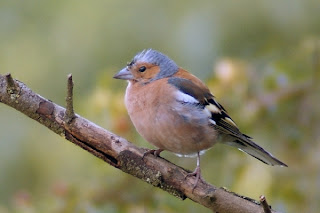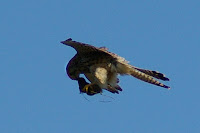 to put the new camera through its paces again.
to put the new camera through its paces again.Despite my assertions that my long lens (a relatively cheap Tamron 70-300) is by no means a birding lens, I don't think I can be too upset with the results.
The Chaffinch is a standard test shot at the hide - bird just a couple of metres away, light not too bad. The result is pretty good, although I'm not sure it's better than my Panasonic with teleconverter.
The Kestrel shots however could never be taken with the FZ20. I wasn't planning for them, or waiting for the opportunity, but was able to  quickly raise the camera, track the bird as it dropped, and then follow it as it moved away, autofocusing and shooting as it went. The resulting images were relatively small crops from the full image, so I have resized them, sharpened them a little and fractionally adjusted levels (i.e. played around with them a little bit on the computer). The results are not great works of art, but I'm well chuffed, and they certainly show me the potential of the camera system.
quickly raise the camera, track the bird as it dropped, and then follow it as it moved away, autofocusing and shooting as it went. The resulting images were relatively small crops from the full image, so I have resized them, sharpened them a little and fractionally adjusted levels (i.e. played around with them a little bit on the computer). The results are not great works of art, but I'm well chuffed, and they certainly show me the potential of the camera system.
 quickly raise the camera, track the bird as it dropped, and then follow it as it moved away, autofocusing and shooting as it went. The resulting images were relatively small crops from the full image, so I have resized them, sharpened them a little and fractionally adjusted levels (i.e. played around with them a little bit on the computer). The results are not great works of art, but I'm well chuffed, and they certainly show me the potential of the camera system.
quickly raise the camera, track the bird as it dropped, and then follow it as it moved away, autofocusing and shooting as it went. The resulting images were relatively small crops from the full image, so I have resized them, sharpened them a little and fractionally adjusted levels (i.e. played around with them a little bit on the computer). The results are not great works of art, but I'm well chuffed, and they certainly show me the potential of the camera system. 




